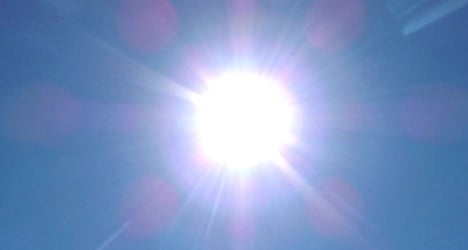The temperature reached 39.7C in Geneva on Tuesday afternoon, the hottest ever recorded in Switzerland north of the Alps, the national weather office MeteoSwiss reported.
It was also the highest registered in Geneva, beating the previous record of 38.9C set in 1921, although it fell short of the all-time record high for Switzerland of 41.5C in Grono, a municipality of the Mesolcina valley in the canton of Graubünden during a heatwave in 2003.
Records fell in other cities in French-speaking Switzerland such as Nyon (38 degrees) and Payerne (37.9C) in the canton of Vaud (38C), Neuchâtel (37.8C), Fribourg (36.6C) and Sion (37.8C) in the canton of Valais.
Bern, the Swiss capital, also posted a new record high of 36.8 degrees, MeteoSwiss said.
“In summary we can say it was the second or third hottest day ever registered in Switzerland,” Frédéric Glassey, of MeteoNews told the ATS news agency.
In Geneva, the heat forced authorities to close the city’s municipal libraries, while its art and history museum shut its doors on the weekend.
The hot weather has also boosted ozone levels, prompting authorities to offer commuters reduced fares for public transit in a bid to encourage motorists to leave their cars at home.
Lakeside beaches and river swimming areas have been inundated with people seeking to beat the heat but at least seven people have drowned in the past week.
The latest incident involved a man who died in Lake Geneva while swimming off the waterfront of the Perle du Lac park, near the World Trade Organization's headquarters.
Cantonal police said the man's body was found about 15 metres from shore and that he died at around 5.30pm.
No other details were immediately available.
The heatwave, which started last Wednesday, has lasted seven days, which is rare for Switzerland.
Blistering hot temperatures were also recorded in other European countries, including Spain and France as warm air pushed north from Africa and the Iberian Peninsula.
MeteoSwiss issued level 4 alerts for hot weather (out of a scale of five).
But it switched its warnings to storm alerts for late Tuesday, with a high risk of heavy rain, strong winds and hail extending from Geneva to include the Jura, the western Alps and the Bernese Oberland.
Maximum temperatures are set to fall to between 19C and 27C in western Switzerland, while top temperatures in German-speaking Switzerland are not expected to exceed 24C.
In southern canton of Ticino highs of around 31C are forecast.




 Please whitelist us to continue reading.
Please whitelist us to continue reading.
Member comments